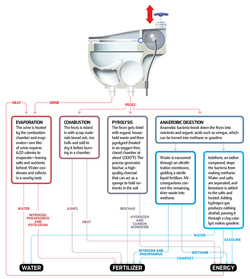 The Airborne Laser Test Bed Missile Defense Agency The Missile Defense Agency’s Airborne Laser Test Bed (ALTB) is dead after a long battle with Pentagon budgetary priorities and Congress. ALTB is best remembered for being a far-out directed-energy beam missile defense interceptor that dodged cancellation by the SecDef himself in 2010 by successfully zapping a test missile from the sky, earning it $40 million more and a new lease on life. But even ALTB couldn’t survive last week’s federal budget slashing. ALTB was sixteen years and several billion dollars old. It will be laid to rest at the the Air Force’s Maintenance and Regeneration Group, known as “The Boneyard.” It is survived by the Navy’s Free Electron Laser.
0 Comments
 Earth’s clouds are sinking lower in the sky, with fewer clouds at high altitudes and lower cloudtops in general, says a new analysis of satellite data. The coming fog means that Earth will cool down more efficiently — so the lowering of clouds could slow the effects of global warming. This potential negative feedback loop is evident in about 10 years of satellite data, so not much at all in the grand scheme of climate research. But it’s a hint that something interesting is happening, according to Roger Davies, the lead researcher on a new paper based on findings from NASA’s Terra spacecraft. Related ArticlesLasers Could Create Clouds, and Perhaps Rain, on DemandChinese Government Plans to Cause Ten Percent More Rain By 2015Is Pollution Slowing Global Warming?TagsScience, Rebecca Boyle, climate change, clouds, earth satellites, global warming, nasa, Terra remote-sensing satelliteSeveral NASA assets look at clouds in a variety of ways, measuring their size, structure, formation, altitude and other vitals. The data is important for weather forecasting as well as long-term climate forecasting. Among other instruments, the Terra satellite contains nine cameras at different angles that produce 3-D images of clouds around the world. The satellite launched in 1999 and the new study examined its first decade of data. The data show that global average cloud height declined by roughly one percent over the decade, decreasing by around 100 to 130 feet. This was mostly the result of fewer clouds forming at the highest altitudes, according to a NASA release. Scientists are not sure why this happened, but it might be due to a change in atmospheric circulation patterns at high altitudes, Davies said. But they do know what it could mean: A drop in cloud height would allow more heat to escape the Earth into space, reducing the overall temperature of the planet. So differences in cloud formation, wrought by a warming climate, could help counteract the effects of that warming. For all their impact on our weather and our moods, clouds are one of the most poorly understood variables in climate change models. Terra and other cloud-watchers, notably CloudSat, aim to improve cloud representation in those models. Terra is scheduled to keep gathering this type of data for another decade, so maybe by 2020 we’ll know what the clouds are up to. Horses Big and Small This illustration shows the ancient horse ancestor Sifrhippus sandrae (right) touching noses with a modern Morgan horse, the latter which stands about 5 feet high at the shoulders and weighs 1,000 lbs. Sifrhippus, by contrast, was the size of a small house cat (about 8.5 lbs.) at the beginning of the Eocene (~55.8 million years ago). It is the earliest known horse. [Illustration by Danielle Byerley, Florida Museum of Natural History Back in the day of the first mammals, horses started out the size of house cats, weighing about 8 pounds and standing only a few inches tall. Then they got even littler, a direct result of the warm temperatures that characterized the Eocene era. Only when Earth cooled down a bit did the beasts get big, according to a new study — the first evidence that temperature directly affects body size. Interesting results when you think about rising global temperatures. Are Earth’s animals about to undergo a New Shrinkening? In about three-quarters of mammals, a truism called Bergmann’s rule holds that animals are smaller in hot climates and bigger in cold climates. Think about wooly mammoths versus Madagascan tenrecs. But a debate persists about why this is so, and whether it’s because of temperature itself or because of indirect results, like food abundance and conservation of heat energy. Ross Secord and colleagues set out to answer this question by studying horses from now and in the past. About 56 million years ago, the Earth warmed up during a phase known as the Paleocene-Eocene Thermal Maximum, or PETM. Carbon dioxide increased and global average temperatures rose by about 5 to 10 degrees Celsius. At least in horses, body sizes went down as temperature went up. Related ArticlesEndangered Wild Horses Get a Health CheckStem-Cell Therapy Works Wonders for Race Horses; Are Human Treatments Next?Europe Pledges Over $10 Billion for Climate Change Adaptation in Developing NationsTagsScience, Rebecca Boyle, animals, body plan, climate change, EVOLUTION, global warming, horses, paleontology, pint sizeThe little horse in the picture above is called Sifrhippus sandrae, and he is the earliest known horse. The species probably came to North America and Europe from a high-latitude land bridge that opened during the warming phase. After its arrival, its body size shrank by 30 percent over the next 130,000 years, Secord and colleagues say. They considered the dryness of environments, atmospheric pressure and even the nutritional content of plants exposed to higher levels of carbon dioxide, and ultimately conclude that temperature was the primary driver of size evolution in Sifrhippus. Their paper appears today in Science. So does this mean that global warming will make us all smaller? Taken to its furthest extent, this hypothesis sounds like some sort of Malthusian dream. Smaller humans would likely require less food. That means we would require less land on which to grow the food. Then we would use less fertilizer, and we’d need fewer factories to make fewer tractors to plow the fields on which we harvest the smaller amounts of food. Fewer factories=less energy requirements=fewer carbon dioxide emissions=less global warming? Sound crazy? Maybe, but I’m not the first person to say this. Philip Gingerich, a researcher at the University of Michigan who first noticed decreasing body size during the PETM, said he jokes about this all the time. “We're going to be walking around 3 feet tall if we keep going the way we're going,” he said. “Maybe that's not all bad and if that's the worst it gets, it will be fine. You can either adapt, or you go extinct, or you can move, and there's not a lot of place to move anymore, so I think it's a matter of adaptation and becoming smaller.” Like NASA’s new cloud-cooling study, this vision of the future is an almost poetic example of nature taking its course in spite of us. Things really do want to even out in the end. Video: Wireless Devices Swim Through Your Bloodstream and Fix You Up, 'Fantastic Voyage' Style Deliver drugs, run tests and remove blood clots 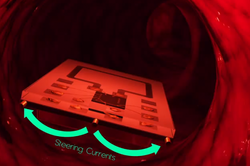 Implantable medical devices will eventually dispense drugs, get rid of blood clots and perform micro-surgeries inside our bodies, but powering them could be problematic. If the point is to have minimally invasive gadgets keeping tabs on our health, cutting patients open to swap out their batteries is not an ideal situation. A new micro device solves that problem elegantly, while upending some assumptions about how our bodies work. It’s powered by induction, which thanks to some new calculations has been shown to work much better in our bodies than anyone thought. All you need is an external radio transmitter to keep it humming. Related ArticlesA Wirelessly Controlled Pharmacy Dispenses Drugs From Within Your AbdomenStretchable Nanogenerators Could Use Lung Motion to Power Medical ImplantsGold Nanosensors Can Be Implanted in the Body to Continuously Monitor for Blood Clots and Trace ProteinsTagsTechnology, Rebecca Boyle, bloodstream, magnetic induction, mechanical diagnostics, medical devices, medical implants, Video, wirelessStanford engineering professor Ada Poon demonstrated a new wireless device at the International Solid-State Circuits Conference this week. It can travel in the bloodstream, propelling itself through blood vessels and performing an array of tasks. A radio transmitter outside the body sends a signal to a magnetically coupled antenna, and any change in the transmitter’s current induces a voltage in the antenna. In previous research, engineers have assumed device antennas would have to be fairly large to work inside the body and receive a signal through all that tissue and fluid and fat. But it turns out this assumption was wrong, as a Stanford news release explains it. Poon rethought some calculations, and instead of considering bone and muscle as electrical conductors, she thought of them as a dielectric, a type of insulator. Her calculations showed that while human tissue is a poor conductor, radio waves travel through them 100 times farther than originally thought. So this means antennae could be 100 times smaller than everyone thought, and still be just as powerful. The antenna on the device Poon demonstrated at the conference is just two millimeters square. She already developed two prototypes, which both create their own propulsion by driving an electrical current through bodily fluid. It may be some time before patients swallow antenna-pills for diagnostic testing, but when they do, they may look a lot like this. New Tubes: Redesigning the Toilet to Produce Water, Fertilizer, and Energy About 2.6 billion people worldwide do not have access to a sanitary toilet. To fix this, the Bill and Melinda Gates Foundation awarded eight grants last year to scientists and engineers to invent a toilet that could function without piped water, a sewer system or outside electricity—and would cost less than 5 cents a day to operate. With the funding, scientists are working on using processes such as evaporation, combustion, pyrolysis and anaerobic digestion to break down waste in toilets into three essential resources: water, fertilizer and fuel.
START: THE CAN Just as separating paper from plastic makes recycling more efficient, separating urine from feces makes the production of energy sources, fertilizer and sterile water more efficient. In Europe, people already use toilets that divide urine from feces. Now scientists have designed a separating toilet for areas without running water that includes a hand pump to operate pneumatic tubes that whisk the waste away. 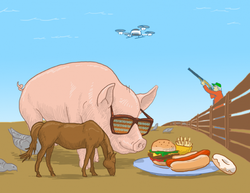 Ah, a nice bucolic, all-American farm scene. Pigs with augmented-reality glasses browse a plate of fast food with prehistoric housecat-sized horses. A farmer shoots a drone. Dear all other countries: this is what it's really like here. Want to win this patriotic Baarbarian illustration on a T-shirt? It's easy! The rules: Follow us on Twitter (we're @PopSci) and retweet our This Week in the Future tweet. One of those lucky retweeters will be chosen to receive a custom T-shirt with this week's Baarbarian illustration on it, thus making the winner the envy of their friends, coworkers and everyone else with eyes. (Those who would rather not leave things to chance and just pony up some cash for the t-shirt can do that here.) The stories pictured herein:
The Six Places on Earth That Most Resemble Other Planets Space researchers uses deserts, valleys, and freezing lakes to test equipment and simulate procedures on space missions. Here's where they put future exploration to the test - without leaving our planet 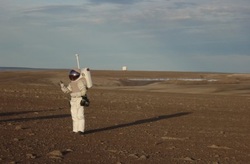 To get into space, we have to practice at home. That's the idea behind NASA's Earth Analogs program, which tests people, ideas and technology at a variety of inhospitable places around the world. Finding places on Earth with physical similarities to space sites isn't easy - but the space agency has located desert, volcanic, arctic, lake and ocean locations for testing all manner of things. GREEN HOMES 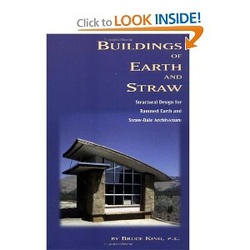 Click on image to buy from Amazon.com Buildings of Earth and Straw: Structural Design for Rammed Earth and Straw Bale Architecture by Bruce King, 1997. This book fills in the gaps for professional builders, contractors, engineers, inspectors, lenders, and architectural students. It includes special construction requirements of earth and straw, design capabilities and limitations of these materials, and documentation of testing data for use in addressing the concerns of officials. This book offers the nuts and bolts of rammed earth and straw bale building techniques, and why they are so spectacular, durable, and earth-friendly.
Start blogging by creating a new post. You can edit or delete me by clicking under the comments. You can also customize your sidebar by dragging in elements from the top bar.
|
PTAH
ONE OF THE GREATEST INNOVATORS OF OUR TIME . PTAH WAS THE FIRST DURING THE GAS CRISIS TO LET ALL OF US Archives
July 2020
Categories |
|
|
- KAM
- don't jump into the pacific ocean or evacuate earth 'yeah nothing like that"
- sum moore
- Now it'z Our TIME
- The 1
- multipolar harmonicz
- laptop gate
- zaporozhye nuclear power plant news
- fukushima
- fallout/ radiation
- BOARDER BLOG
- terrorist state
- food now
- Climate change we must Change
- FOCUS FILMZ POLITICAL
- IZM GALLERY
- IZM TV/NEWS
- YOU KNOW WHO IT IZ
- ON YOUR BACK & BEYOND STYLE
- izm party
- Global biz
- ASCENDING MASTERS
- WHAT'Z UP WITH IT
- WORLD WIDE PEACE AND LOVE OR WAR
- JOURNEY OF PTAH
- INNOVATION
- tech/ cyber.S
- colonial semi yuanizm
- WHAT IZMIST DO
- GOLDEN AGE
- focus filmz
- cosmic alignment 2012
- THE PEACE AND LOVE FOUNDATION INC
- PROBLEMS IN LIES THE SOLUTION
- planet DISNEY
- melting pot
- fallout/radiation videos and info
- planet Elizabeth Taylor
- FOCUS FILMZ POLITICAL ON LOCATION
- we R the children
- books of knowledge
- Nu age
- TRUTHIZM" they will watch you die"
- CHEIF
- source of allmediaizm
- ptah messages from the beyond"
- COVID/19
- HEMP & CANOPY NEWZ
- CHINA BLUEIZM
- 4LIGHT IZ ZOUND

